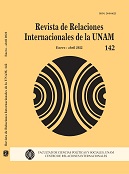El nervio de la guerra: panorama del gasto militar 2000-2019
Contenido principal del artículo
Resumen
Este artículo tiene como objetivo establecer las jerarquías internacionales en el ámbito del gasto militar, considerando que ese tipo de inversiones constituye uno de los principales elementos de la disputa por la hegemonía mundial: el gasto militar refleja las “voluntades” nacionales para fortalecer las actividades de defensa y seguridad, destinando a ello mon tos significativos de la riqueza social, de suerte que su crecimiento indica tanto el peso específico creciente de las fuerzas armadas en las sociedades contemporáneas, como la situación que guardan las relaciones asimétricas entre el hegemón estadounidense y sus eventuales competidores. Se incluye también un análisis del gasto militar entre las naciones latinoamericanas que realizan inversiones significativas en el campo militar, con el fin de mostrar que esta región no es ajena a las tendencias autoritarias en curso. Se presentan las tendencias generales de los gastos en defensa tanto de las principales potencias (Estados Unidos, China, Reino Unido, Rusia, Japón, Francia Arabia Saudí, Alemania, India y Corea del Sur), y los principales inversionistas de América Latina: Brasil, México, Colombia, Chile y Argentina, para el periodo 2000-2019. El análisis de estas tendencias indica la importancia creciente de las actividades militares en el capitalismo contemporáneo: en el marco de una sobreacumulación generalizada, del paulatino debilitamiento del imperio estadounidense y de la emergencia de potencias regionales, se ha producido un importante aumento de los recursos destinados a las actividades de defensa.
